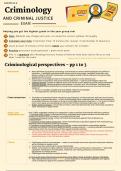Samenvatting
Summary GLB: 620295-B-6 - Criminology and Criminal Justice
- Instelling
- Tilburg University (UVT)
The exam is right around the corner. Are you drowning in endless material for the Criminology and Criminal Justice course? Struggling to keep your notes organized, clear, and exam-ready? Stop stressing! My notes are the solution you’ve been looking for. These aren’t just notes – the...
[Meer zien]







